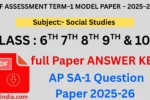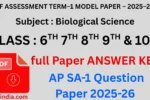Class 9th Physical Science Self-Assessment Model Paper – I
(2025-26)
Time: 1 hour
Maximum Marks: 35
Part – A (Multiple Choice Questions – MCQ)
(Each question carries 1 mark)
- Which of the following is a property of solids?
a) No fixed shape
b) Fixed shape and fixed volume
c) Takes the shape of the container
d) Flow freely - What is the SI unit of force?
a) Newton
b) Joule
c) Watt
d) Pascal - The pressure exerted by a liquid in a container is:
a) Constant at all points
b) Inversely proportional to the depth
c) Directly proportional to the depth
d) Independent of the depth - Which of the following is an example of a physical change?
a) Burning of paper
b) Rusting of iron
c) Melting of ice
d) Digesting food - What is the formula for calculating density?
a) Density = Mass/Volume
b) Density = Mass × Volume
c) Density = Force × Area
d) Density = Pressure × Volume - Which of the following is true about gases?
a) Gases have a definite volume but no definite shape.
b) Gases have neither a definite shape nor a definite volume.
c) Gases have a definite shape but no definite volume.
d) Gases have both a definite shape and volume. - Which of these properties increases with temperature in gases?
a) Density
b) Pressure
c) Volume
d) Weight - Which of the following is an example of a chemical change?
a) Freezing water
b) Dissolving salt in water
c) Burning wood
d) Melting wax - The density of a substance is defined as:
a) The amount of mass in a given volume
b) The amount of pressure exerted in a substance
c) The amount of temperature in a substance
d) The force per unit area - In the equation $F = ma$, what does ‘a’ represent?
a) Acceleration
b) Area
c) Angle
d) Amount
Part – B (Very Short Answer Questions – VSAQ)
(Each question carries 2 marks)
- Define pressure and give its SI unit.
- What is the difference between physical and chemical changes?
- State Archimedes’ principle.
Part – C (Short Answer Questions – SAQ)
(Each question carries 4 marks)
- Explain the relationship between force, mass, and acceleration in Newton’s Second Law of Motion.
- Calculate the pressure exerted by a force of 100 N on an area of 2 m².
- Describe the properties of liquids with examples.
Part – D (Long Answer Question – Essay)
(1 question – 8 marks)
Discuss the properties of matter in detail. Explain how the three states of matter—solid, liquid, and gas—differ in terms of shape, volume, and particle arrangement. Include examples in your answer.
Answer Key
Part – A (MCQ):
- b) Fixed shape and fixed volume
- a) Newton
- c) Directly proportional to the depth
- c) Melting of ice
- a) Density = Mass/Volume
- b) Gases have neither a definite shape nor a definite volume.
- b) Pressure
- c) Burning wood
- a) The amount of mass in a given volume
- a) Acceleration
Part – B (VSAQ):
- Pressure is defined as force per unit area. Its SI unit is Pascal (Pa).
- Physical changes are those that do not alter the chemical composition of the substance, like freezing water. Chemical changes result in the formation of new substances, like burning wood.
- Archimedes’ principle states that an object submerged in a fluid experiences an upward buoyant force equal to the weight of the fluid displaced by the object.
Part – C (SAQ):
- Newton’s Second Law states that the force applied on an object is directly proportional to its mass and the acceleration it produces. Formula: $F = ma$. If mass increases, the force needed to accelerate the object increases, and if acceleration increases, the force also increases.
- Pressure $P = \frac{F}{A} = \frac{100 \, \text{N}}{2 \, \text{m}^2} = 50 \, \text{Pa}$.
- Liquids have a fixed volume but no fixed shape, taking the shape of their container. For example, water in a bottle takes the shape of the bottle but remains at a constant volume.
Part – D (Essay):
- Solid: Solids have a fixed shape and volume because their particles are tightly packed and vibrate in place. Example: Ice cube.
- Liquid: Liquids have a fixed volume but no fixed shape, as their particles are loosely packed and move around each other. Example: Water.
- Gas: Gases have neither a fixed shape nor a fixed volume. The particles are far apart and move freely. Example: Oxygen in the air.
Ah, I see! You want a Class 9 Biological Science Self-Assessment Question Paper based on the syllabus you shared, specifically focusing on topics related to Biology (e.g., Cell Structure, Life Processes, etc.) for the 2025-2026 academic year.
Here’s a question paper based on those topics:
Class 9 – Biological Science Self-Assessment question Paper – I
(2025-26)
Time: 1 hour
Maximum Marks: 35
Part – A (Multiple Choice Questions – MCQs)
(Each question carries 1 mark)
- Which of the following is a part of the cell responsible for controlling the activities of the cell?
a) Mitochondria
b) Nucleus
c) Ribosomes
d) Golgi Apparatus - Which of the following is the main component of the plasma membrane in cells?
a) Proteins
b) Carbohydrates
c) Lipids
d) Nucleic acids - Which of these is the primary function of chloroplasts?
a) Respiration
b) Photosynthesis
c) Digestion
d) Transport - Which of the following is not a part of the human circulatory system?
a) Heart
b) Lungs
c) Blood
d) Stomach - What is the process of converting food into energy in cells called?
a) Photosynthesis
b) Digestion
c) Respiration
d) Transpiration - Which organelle is responsible for producing energy in the form of ATP?
a) Ribosomes
b) Mitochondria
c) Endoplasmic reticulum
d) Lysosomes - The process by which plants lose water vapor through the stomata is called:
a) Respiration
b) Photosynthesis
c) Transpiration
d) Absorption - Which of the following is responsible for the transport of water in plants?
a) Phloem
b) Xylem
c) Cambium
d) Epidermis - Which of the following is the basic structural and functional unit of life?
a) Organ
b) Tissue
c) Cell
d) Organism - Which of the following is responsible for the formation of food in plants?
a) Chloroplast
b) Mitochondria
c) Ribosomes
d) Nucleus
Part – B (Very Short Answer Questions – VSAQ)
(Each question carries 2 marks)
- Define respiration. How is it different from breathing?
- What is the role of the mitochondria in the cell?
- Explain the process of transpiration in plants.
Part – C (Short Answer Questions – SAQ)
(Each question carries 4 marks)
- Describe the structure and function of the cell membrane.
- What are the different types of tissues found in plants? Briefly describe their function.
- Explain the process of photosynthesis and its importance in the ecosystem.
Part – D (Long Answer Question – Essay)
(1 question – 8 marks)
Discuss the life processes in plants and animals. Explain the processes of respiration, nutrition, and excretion in both. Use examples where necessary.
Answer Key
Part – A (MCQ):
- b) Nucleus
- c) Lipids
- b) Photosynthesis
- d) Stomach
- c) Respiration
- b) Mitochondria
- c) Transpiration
- b) Xylem
- c) Cell
- a) Chloroplast
Part – B (VSAQ):
- Respiration is the process by which living organisms convert oxygen and glucose into energy (ATP), carbon dioxide, and water. It differs from breathing, which is the physical process of taking in oxygen and expelling carbon dioxide.
- Mitochondria are the powerhouse of the cell. They generate energy in the form of ATP through cellular respiration, which is used for various cell functions.
- Transpiration is the process by which water vapor is lost from plants through tiny openings called stomata. It helps in the uptake of water and minerals from the roots and maintains the plant’s temperature.
Part – C (SAQ):
- The cell membrane is a thin, flexible layer that surrounds the cell, providing structure and protection. It controls the entry and exit of substances in and out of the cell through selective permeability.
- In plants, the main types of tissues are:
- Meristematic tissue: Involved in growth and division.
- Permanent tissue: Includes xylem (transport of water), phloem (transport of food), and parenchyma (storage and support).
- Photosynthesis is the process by which plants convert carbon dioxide and water into glucose and oxygen, using light energy absorbed by chlorophyll. It is essential for producing food and oxygen, which supports life on Earth.
Part – D (Essay):

